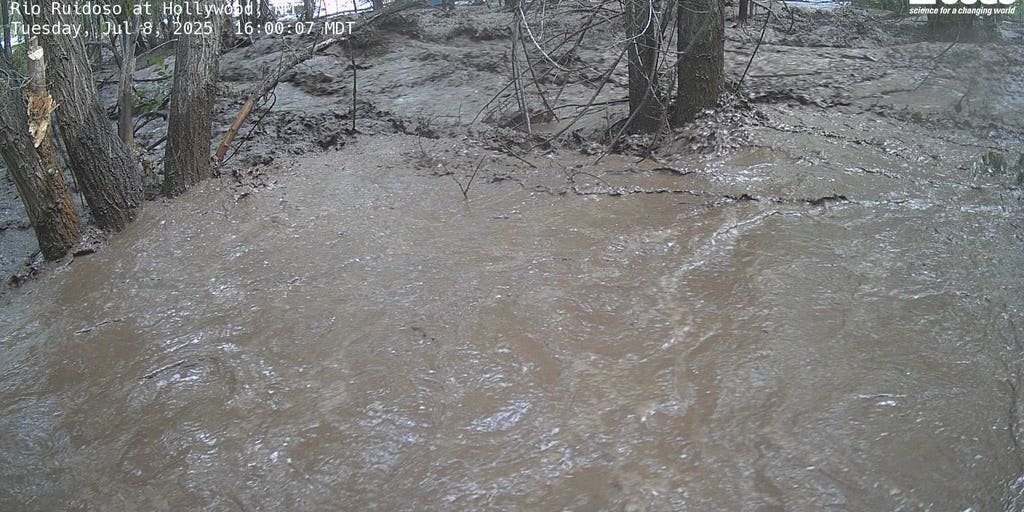Flash Floods in Ruidoso: A Community in Crisis
As residents of Ruidoso, New Mexico, prepared for an ordinary Tuesday, the skies darkened ominously. Suddenly, a torrent of rain unleashed itself upon the small mountain town, sending floodwaters surging down streets where children had played just hours before. Emergency alerts screamed across local channels, warning residents of a Flash Flood Emergency as the Rio Ruidoso reached perilous levels, stretching past 15 feet. The urgency was palpable; lives were at stake.
The Impact of Burn Scars and Climate Change
Ruidoso’s predicament is not an isolated incident but a sign of an alarming trend. Rainfall rates have intensified in recent years, often overwhelming communities unprepared for such rapid deluges. Following the devastating South Fork Fire, the region’s burn scars have made it particularly vulnerable to flash flooding. According to meteorologist Dr. Elise Farrow of the University of New Mexico, “The risk of catastrophic flooding in areas affected by wildfires has increased, as the burned soil can repel water, generating runoff instead of absorption. This incident in Ruidoso exemplifies that risk.”
Flooding: More than Just Water
The implications of such extreme weather go beyond immediate physical dangers. Social scientist Dr. Marcus Chen conducted a study on flood impact on community well-being, stating, “Extreme weather events like floods can lead to long-term psychological issues among residents such as anxiety and PTSD. Communities need to prepare not only for the physical aftermath but also for the emotional toll these events take.”
Emergency Response and Community Resilience
As floodwaters cascaded through Ruidoso, emergency responders were mobilized swiftly. Many residents found themselves stranded, necessitating water rescues throughout the city. Reports indicated that cell towers were overwhelmed, complicating rescue operations and communications.
- Evacuations: Residents were urged to seek higher ground immediately.
- Rescue Operations: Over thirty individuals were rescued from roofs and trees.
- Infrastructure Damage: Several critical roads became impassable, complicating rescue efforts.
Local authorities worked in unison with the National Weather Service (NWS), which played a crucial role in providing timely updates. Social media platforms became lifelines as residents shared information about safe zones, helping guide neighbors to safety. “Social networks can facilitate rapid information sharing in times of crisis,” noted Dr. Laura Singh, a communications expert. “The community’s response during this flood exemplifies resilience through shared resources.”
Looking Ahead: Preparedness Culture
The Flash Flood Emergency in Ruidoso has rekindled discussions around emergency preparedness and climate resilience among local leaders and residents. A hypothetical study by the Rebuilding Resilience Institute indicates that communities with robust preparedness plans are less likely to suffer long-term damages in disaster scenarios.
Key recommendations from experts suggest:
- Community training sessions on emergency response strategies.
- Investments in flood mitigation infrastructure.
- Collaboration with scientific institutions to forecast and prepare for changing weather patterns.
The convergence of technological advances and community effort may dictate Ruidoso’s capacity to withstand future climatic assaults. Yet, even amidst despair, a thread of hope emerges as residents band together to rally in such tumultuous times. Through shared stories and collective action, they are not only surviving but building the intellectual capacity needed to mitigate future disasters.
As the skies gradually clear and the floodwaters recede, Ruidoso stands under a somber awakening—one that reflects a wider trend seen throughout the southwestern United States. While local authorities are commended for their rapid actions, meaningful change requires investment in long-term resilience strategies. The challenges ahead may seem daunting, yet the town’s spirit of unity and determination offers a guiding light in the face of escalating climate threats.









